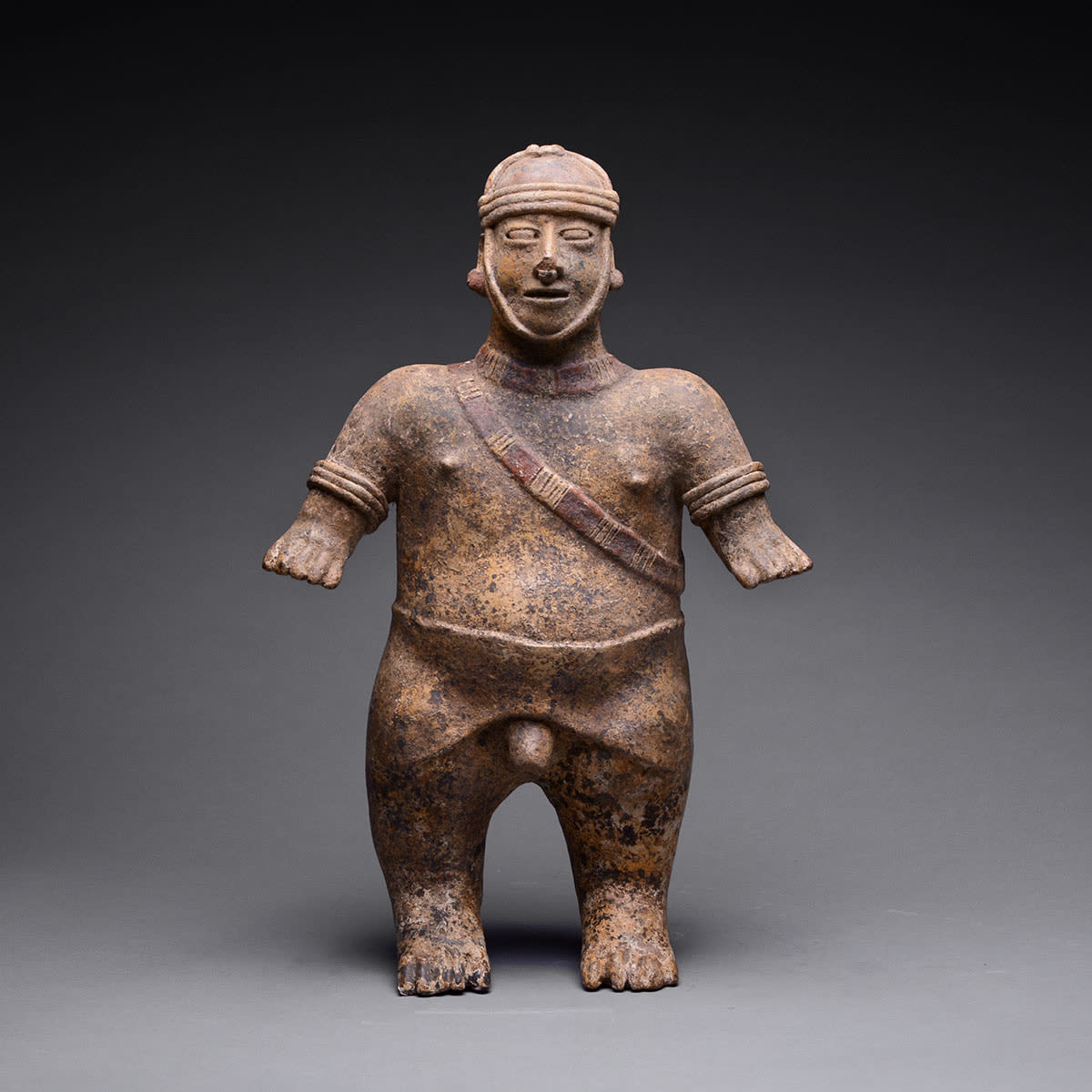El Arenal Brown Style Jalisco Terracotta Sculpture of a Man Wearing a Helmet, 300 BCE - 300 CE
Terracotta
42.5 x 27.9 cm
16 3/4 x 11 in
16 3/4 x 11 in
PF.0560
Further images
There are many distinct groups within the agglomeration referred to as the Western Mexico Shaft Tomb (WMST) tradition, foremost among them the Jalisco, Nayarit, and Colima. Their relationships are almost...
There are many distinct groups within the agglomeration referred to as the Western Mexico Shaft Tomb (WMST) tradition, foremost among them the Jalisco, Nayarit, and Colima. Their relationships are almost totally obscure due to the lack of contextual information. However, it is the artworks that are the most informative. All of the cultures encompassed under the WMST umbrella were in the habit of burying their dead in socially-stratified burial chambers at the base of deep shafts, which were in turn often topped by buildings. Originally believed to be influenced by the Tarascan people, who were contemporaries of the Aztecs, thermoluminescence has pushed back the dates of these groups over 1000 years.
Although the apogee of this tradition was reached in the last centuries of the 1st millennium BC, it has its origins over 1000 years earlier at sites such as Huitzilapa and Teuchitlan, in the Jalisco region. Little is known of the cultures themselves, although preliminary data seems to suggest that they were sedentary agriculturists with social systems not dissimilar to chiefdoms. These cultures are especially interesting to students of Mesoamerican history as they seem to have been to a large extent outside the ebb and flow of more aggressive cultures – such as the Toltecs, Olmecs and Maya – in the same vicinity. Thus insulated from the perils of urbanization, they developed very much in isolation, and it behooves us to learn what we can from what they have left behind.
There are few cultures in the Americas or indeed elsewhere that can match the Jalisco for exuberant skill in the production of figurative ceramics. These wares were usually placed in graves, and do not seem to have performed any practical function, although highly decorated utilitarian vessels are also known. It is possible that they were designed to depict the deceased – they are often very naturalistic – although it is more probable that they constituted, when in groups, a retinue of companions, protectors and servants for the hereafter. Many of the figures represent warriors, judging from their apparel and martial stance. These were probably protectors of the deceased, symbolic of actual people who were buried with the deceased as retainers in more sanguineous Central and Southern American societies. Supernatural and more enigmatic figures are also known, presumably representing aspects of Jalisco cultural heritage (gods, spirits, ancestors, mythological figures etc) that cannot be understood at the present time. However, perhaps the best-known style is that of the maternity figure.
Wearing a helmet and a short, heavy skirt, this splendid figure still carries traces of bright red paint on the sash that encircles his chest and neck. His stance is confident, even agressive. He is perhaps a warrior, a veteran, used to winning and unafraid of confrontation. His powerful presence would strike fear into his opponents; let us be glad that he is on our side.
Although the apogee of this tradition was reached in the last centuries of the 1st millennium BC, it has its origins over 1000 years earlier at sites such as Huitzilapa and Teuchitlan, in the Jalisco region. Little is known of the cultures themselves, although preliminary data seems to suggest that they were sedentary agriculturists with social systems not dissimilar to chiefdoms. These cultures are especially interesting to students of Mesoamerican history as they seem to have been to a large extent outside the ebb and flow of more aggressive cultures – such as the Toltecs, Olmecs and Maya – in the same vicinity. Thus insulated from the perils of urbanization, they developed very much in isolation, and it behooves us to learn what we can from what they have left behind.
There are few cultures in the Americas or indeed elsewhere that can match the Jalisco for exuberant skill in the production of figurative ceramics. These wares were usually placed in graves, and do not seem to have performed any practical function, although highly decorated utilitarian vessels are also known. It is possible that they were designed to depict the deceased – they are often very naturalistic – although it is more probable that they constituted, when in groups, a retinue of companions, protectors and servants for the hereafter. Many of the figures represent warriors, judging from their apparel and martial stance. These were probably protectors of the deceased, symbolic of actual people who were buried with the deceased as retainers in more sanguineous Central and Southern American societies. Supernatural and more enigmatic figures are also known, presumably representing aspects of Jalisco cultural heritage (gods, spirits, ancestors, mythological figures etc) that cannot be understood at the present time. However, perhaps the best-known style is that of the maternity figure.
Wearing a helmet and a short, heavy skirt, this splendid figure still carries traces of bright red paint on the sash that encircles his chest and neck. His stance is confident, even agressive. He is perhaps a warrior, a veteran, used to winning and unafraid of confrontation. His powerful presence would strike fear into his opponents; let us be glad that he is on our side.











